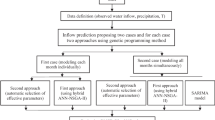Abstract
The urbanization of an undeveloped area often shortens outflow travel time and increases peak discharge from the basin, thereby increasing the downstream flood frequency. Stormwater detention ponds are the most common measure to maintain the outflow from the post-developed basin to a flow similar to that under the pre-developed condition. The design criteria of stormwater detention ponds are to minimize construction cost while achieving the flood control purpose. The tedious and time-consuming, trial-and-error method is commonly used to determine the optimal size and location of the pond and outlet structure for a design storm period. In this study, a stochastic search algorithm, a Genetic Algorithm (GA), is used to optimize the detention pond design. The decision variables are the pond storage, and the pipe diameters and number of pipes for the service outlet. The flood control objective considered in this study is that the peak discharge in the post-developed condition does not exceed that under the pre-developed condition and that the maximum water level in the pond during the flood remains below the allowable water level. The proposed optimization algorithm method was applied to the real design of two detention ponds in South Korea, where it generated better design options comprising smaller pond storage and smaller outlet standpipe dimensions than those of the traditional trial-and-error method, and in a much shorter computational time. Therefore, the stochastic search algorithm, GA, can be successfully applied in the design of a stormwater detention basin to improve accuracy and convenience. The engineers can accordingly assess the development plan in terms of the potential basin disaster more efficiently than is possible when using the tedious computation method.
Similar content being viewed by others
References
Akan, A. O. (1993). Urban stormwater hydrology-A guide to engineering calculations, Technomic, Lancaster, PA, ISBN:0-87762-966-6.
Akan, A. O. and Houghtalen R. J. (2003). Urban hydrology, hydraulics, and stormwater quality, Technomic, Lancaster, PA, ISBN:0-471-43158-3.
American Society of Civil Engineers (1996). Chapter 9 urban hydrology in hydrology handbook, ASCE Manuals and Reports on Engineering Practice No. 28, New York, NY.
Behera, P. K., Papa, F., and Adams, B. J. (1999). “Optimization of regional storm-water management systems.” Journal of Water Resources Planning and Management, Vol. 125, No. 2, pp. 107–114.
Brown, S. A., Stein, S. M., and Warner, J. C. (1996). Urban drainage design manual, Federal Highway Administration, Hydraulic Engineering Circular No. 22, Washington, D.C.
Khu, S. T., Liong, S. Y., Babovic, V., Madsen, H., and Muttil, N. (2001). “Genetic programming and its application in real-time runoff forecasting.” Journal of the American Water Resources Association, Vol. 37, No. 2, pp. 439–451.
Longanathan, G. V., Kibler, D. F., and Grizzard, T. J. (1996). Urban stormwater management in handbook of water resources engineering, Mays, L. (ed.), McGraw-Hill, New York, NY.
Mays, L. W. and Bedient, P. B. (1982). “Model for optimal size and location of detention.” Journal of Water Resources Planning and Management, Vol. 108, No. 3, pp. 270–285.
National Emergency Management Agency (2005). Guideline of the assessment for disaster impact in Korea, NEMA Guideline No. 2005.
Papa, F. and Adams, B. J. (1997). “Application of derived probability and dynamic programming techniques to planning regional stormwater management systems.” Water Science and Technology, Vol. 36, No. 5, pp. 227–234.
Sample, D. J., Heaney, J. P., Wright, L.T., Fan, C-Y., Lai, F-H., and Field, R. (2003). “Cost of best management practices and associated land for urban stormwater control.” Journal of Water Resources Planning and Management, Vol. 129, No. 1, pp. 59–68.
Stahre, P. and Urbonas, B. (1990). Stormwater detention, Prentice-Hall, Englewood Cliffs, NJ.
Taur, C., Toth, G., Oswald, G. E., and Mays, L. W. (1987). “Austin detention basin optimization model.” Journal of Water Resources Planning and Management, Vol. 113, No. 7, pp. 860–878.
Travis, Q. B. and Mays, L. W. (2008). “Optimizing retention basin networks.” Journal of Water Resources Planning and Management, Vol. 134, No. 5, pp. 432–439.
Urbonas, B. and Stahre, P. (1993). Stormwater: Best management practices and detention for water quality, drainage and CSO management, McGraw-Hill, New York, NY.
Wang, Q. J. (1997). “Using genetic algorithms to optimize model parameters.” Environmental Modeling and Software, Vol. 12, No. 1, pp. 27–34.
Yu, S. L. and Kaighn, Jr. (1992). VDOT Manual of Practice for Planning Stormwater Management, Virginia Transportation Council, Charlottesville, VA.
Zhao, B. (1999). “Cost minimization for detention basin system design.” 29th Annual Water Resources Planning and Management Conference, Tempe, Arizona, USA.
Zhen, X.-Y., Yu, S. L., and Lin, J.-Y. (2004). “Optimal location and sizing of stormwater basins at watershed scale.” Journal of Water Resources Planning and Management, Vol. 130, No. 4, pp. 339–347.
Author information
Authors and Affiliations
Corresponding author
Rights and permissions
About this article
Cite this article
Park, M., Chung, G., Yoo, C. et al. Optimal design of stormwater detention basin using the genetic algorithm. KSCE J Civ Eng 16, 660–666 (2012). https://doi.org/10.1007/s12205-012-0991-0
Received:
Revised:
Accepted:
Published:
Issue Date:
DOI: https://doi.org/10.1007/s12205-012-0991-0




